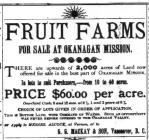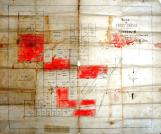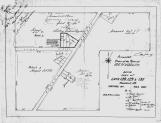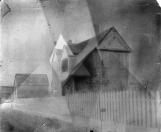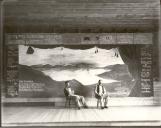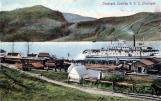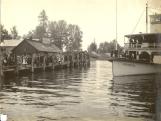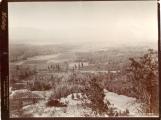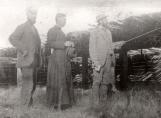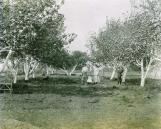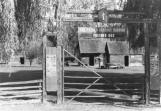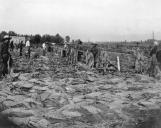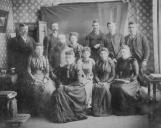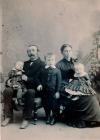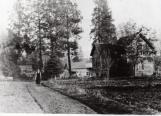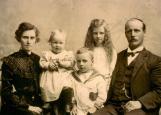

Central Okanagan Heritage Society
Kelowna, British Columbia
1
Portrait of George Grant MacKay3 February 1891
Okanagan Valley, British Columbia
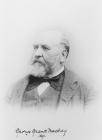 Credits:
Credits:Vernon Museum Public Archives #12044
2
Upon his arrival to the Okanagan in 1890, MacKay, along with Forbes G. Vernon (owner of the Coldstream Ranch) became the principal investors in the Okanagan Land and Development Company. This company was responsible for laying out the new townsite of Vernon in 1891, building the Coldstream and Kalamalka Hotels, installing a water system and publishing the Vernon News which was the valley's first newspaper.3
Advertisement for lots for sale in the town of Vernon by the Okanagan Land and Development Co.June 1892
Vernon, British Columbia
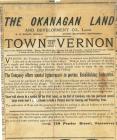 Credits:
Credits:Kelowna Public Archives #2005.219
Vernon News, June 1892
4
In 1890 with the completion of the CPR's transcontinental railway, a wave of change was being felt in the Okanagan. With the Shuswap and Okanagan Railroad in the process of being built, a charter had been granted by the provincial legislature to the Vernon and Okanagan Railway to construct a railroad line that would join the Kettle Valley Railroad to the Boundary mining country and on to the United States. With Vernon established, there were rumours that a Vernon and Okanagan Railway would soon be built running through the Mission Valley to Penticton connecting the CPR to the Great Northern Railway in the United States. MacKay, ever the entrepreneur, was most interested. He felt that this could be his next big development opportunity.By the end of 1890, MacKay had purchased more than 3,000 acres along the railway's most likely route. The land that he bought included: the 480 acre ranch of John McDougall (as their agent, MacKay sold the ranch to the Aberdeen's which became later became known as the Guisachan Ranch); 3,000 acres from Thomas Ellis, 320 acres from Joseph Christien; 320 acres from Alphonse Lefevre; and between 700 - 800 acres from Dan Nicholson (William Pion's original claim) for about $20 per acre.
("Benvoulin Townsite, Original Town Centre", Dorothy Zoellner, 1997)
5
Settlement map of the Mission Valley in 1880Circa 1965-66
Okanagan Mission Valley, British Columbia
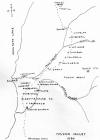 Credits:
Credits:"Ogopogo's Vigil", F.M. Buckland, Okanagan Historical Society, Kelowna Branch, 1979 (revised- fourth printing), p. 62
Primrose Upton (drew map for 1966 second printing)
6
In 1891 after purchasing land in the Mission Valley, along the anticipated railway route, MacKay proceeded to survey and subdivide the land into ten to forty acre parcels. MacKay, under the title of the Okanagan Land and Development Company Limited, advertised the lots for sale in the Vernon News as well as in the Vancouver newspapers.9
To encourage the sale of these lots and in anticipation of the area becoming a railroad stop, MacKay planned a new townsite in the fall of 1891. MacKay saw the "possibilities for further development in the Mission Valley where the rich bottom land would support a much larger population, if it produced fruit and vegetables instead of hay and grain. This was made evident by the small orchards with their few trees around a ranch house and the profusion of vegetables in the kitchen garden." ("Ogopogo's Vigil", F.M. Buckland, 1979, p.78)MacKay named his new townsite, 'Benvoulin'. In Scotland, MacKay had owned a 32 acre property on the Hill of Oban, where he had built a home which he named Benvoulin Lodge (meaning: hill of the mill). In the Okanagan Historical Society (OHS) Report, 1959, volume 23, page 97, Mr. Noel Higgins, from West Summerland confirms that his uncle bought the Scottish property from the MacKay family in the 1890s. "Benvoulin was a fair-sized house and property, situated on the hill overlooking the town of Oban in the Highlands."
The lakefront area where downtown Kelowna is now located was very swampy and low and was not seen as a suitable townsite. The area in Benvoulin however was fairly flat with good soil and seemed perfect for a town centre. The new townsite was laid out about half way between Lequime's store and the Okanagan School, where a newly surveyed road met the Old Mission Trail. It was at the intersection of the wagon roads between the Catholic Mission and Vernon, and the westerly road to Knox's wharf at the base of the mountain (today's intersection of Benvoulin and Byrns Roads).
11
Advertisement of lots for sale in the Benvoulin townsite & rooms for rent at the Benvoulin HotelJune 1892
Benvoulin, British Columbia
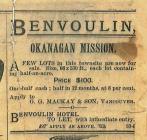 Credits:
Credits:Kelowna Public Archives
Vernon News, June 1892
12
MacKay donated land to the north of the projected town centre for a Presbyterian church (the first in the Mission Valley) in order to encourage the development of his town centre. This became the site of the Bethel Presbyterian Church.The townsite would grow to include a blacksmith shop, a Chinese laundry, a general store, and a ten-room hotel. There was a post office and a store, stocked with general merchandise, owned by noted Canadian poet, Charles Mair. Mair's first store in the area was built in Kelowna in 1892, followed by the second store located at Benvoulin. Built in 1893, the Benvoulin store was operated by his son, Cecil Mairs. A small Chinese laundry operated by Sing Lee was also in the new Benvoulin townsite. Sing Lee washed shirts for 10 cents each.
Sam T. Elliott, who settled in Benvoulin in 1901, built his blacksmith shop on the north side of Haddo Road (Byrns Road). On the south west corner of Gordon and Byrns Road, Cromwell and Holland (of Vernon) built a two and a half story Elizabethan-style hotel. It had ten rooms and a stable in the back. The hotel was completed in June 1892. It was later bought for $4,000 by Dan Nicholson, who came to the Okanagan in 1876. The hotel, stable, general store and blacksmith shop at Benvoulin served the neighbourhood for some fifteen years before the site of the hamlet was abandoned because of the ever-growing City of Kelowna, which could give better service and values. ("Ogopogo's Vigil", F.M. Buckland, 1979, p.94)
17
Newspaper article on Sam Elliott's old blacksmith building being demolished4 July 1978
Kelowna, British Columbia
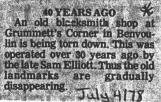 Credits:
Credits:Kelowna Public Archives
The Daily Courier, July 1978
18
The Vernon and Okanagan Railway Company had planned to build south to the Boundary Country through the Mission Valley, where Benvoulin would become a station site. This line, however, was never built. Instead the Shuswap and Okanagan Railway (completed and opened on May 12th, 1892) ran a branch line from Vernon, three miles to the head of Okanagan Lake at Okanagan Landing, where it connected with the Okanagan steamers. This became the route of travel for both freight and passenger for many years. On May 3rd, 1892 the CPR launched the steamboat S.S. Aberdeen on Okanagan Lake. It stopped three times a week at the wharf in the future Kelowna townsite.21
Bernard Lequime realized the transportation advantages now offered on the Lake. In 1890, he arranged to have the property that he and his brother Leon had recently acquired (Auguste Gillard's original pre-emption in 1863) on the waterfront surveyed. Lequime commissioned J.A. Coryell, C.E. and Company, surveyors from Vernon, to lay out the three hundred acre townsite in 1891. Bernard Lequime was among the few who did not buy into MacKay's sales pitch for Benvoulin becoming the new townsite. Bernard remained convinced that Okanagan Lake would be the preferred travel route in the future. Bernard built a wharf and freight shed nearby in order to ensure Kelowna became a travel stop for the lake boats.On August 13th 1892, Bernard Lequime filed Map 462 with the Registrar General in Victoria. MacKay's Benvoulin townsite plan had already been laid out, but not registered (filed) until September 1892. With MacKay's untimely death on January 1st 1893, the driving force behind the Benvoulin townsite was lost.
23
Copy of Lequime's Kelowna townsite plan 4621892 original (copy n.d.)
Kelowna, British Columbia
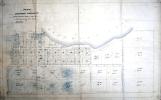 Credits:
Credits:Kelowna Public Archives, #3.07 2005.042.212
24
Many new settlers, mainly British, Scottish and Irish, arrived in the Okanagan Valley looking to buy some land and settle in the new community. George Grant MacKay, with his excellent connections, was able to attract other well-connected people, such as Lord and Lady Aberdeen, Scottish aristocrats interested in Canada. The Aberdeens arrived in Vancouver in October 1890, as part of their cross-Canada tour. The Aberdeens wanted to purchase a holiday retreat in Western Canada and with Lady Aberdeen's brother Coutts Marjoribanks, needing to be relocated from North Dakota, they had someone available to manage it for them.The Aberdeen's had a previous connection with G.G. MacKay, as he had been the engineer in charge of building roads near Lady Aberdeen's ancestral home in Inverness-shire. When the Aberdeens arrived in Vancouver, they re-established contact with G.G. MacKay, who was well established in the real estate business in Vancouver. As the couple had little time to look at property during their short stay, they asked MacKay to act on their behalf and purchase property. MacKay's first suggestion was the Fraser Valley, which at $50-$60 per acre was deemed to be too costly. MacKay's second suggestion was the Mission Valley, selling to the Aberdeens some of the land he had bought on speculation and was planning to subdivide. The Aberdeens bought the 480 acre McDougall homestead, with MacKay's assurances that a new railway would soon be built through the area and would therefore increase the property's value tenfold from its original purchase price of $10,000. This enticed the couple to purchase the property sight unseen. Coutts Marjoribanks, with the help of a friend and the new ranch manager, had a new house built, in the Indian colonial bungalow style. Lady Aberdeen renamed the property Guisachan ('Place of the Fir' in Gaelic) after her childhood home in Inverness-shire, Scotland.
27
The Aberdeens returned to B.C. in the fall of 1891, and met up with G.G. MacKay in the Mission Valley as well as met many of the area's local people. They stayed for ten days (October 14th arrived and left on October 24th 1891) at their Guisachan Ranch and attended many social activities in the new community. These activities, the people that they met, descriptions of their new property and the surrounding area and Lady Aberdeen's personal thoughts are recorded in detail in her diary. Some of the activities that the Aberdeens attended included: a bear hunt; checked out their new Guisachan property; a visit by the Presbyterian minister Rev. Langill (discussion of plans to build a new church and Lord Aberdeen's promise to donate $400 towards the new building); a visit to Father Pandosy's Mission; attended church services at the Okanagan School as well as held an informal service at Guisachan (described by Lady Aberdeen as: "meant to be as a sort of exchange of greetings amongst new neighbours in the best way..."; located in "The Journal of Lady Aberdeen the Okanagan Valley in the Nineties" annotated and edited by R.M. Middleton, 1986, p. 28); held the first 'social' ever in the valley at Guisachan; expedition to Long Lake followed by tea at the Postill Ranch.29
Excerpt from Lady Aberdeen's diary at Guisachan Ranch on October 16th 189116 October 1891
Guisachan Ranch, Okanagan Mission, British Columbia
October 16, 1891. Guisachan Ranch, B.C.
Mr. Langell, the Presbyterian minister, called in the morning. He comes out to this valley from Vernon every Sunday, taking service one week at this end in the schoolhouse and the other at Mr. Postill's at the upper end going back to Vernon (35 miles) for an evening service. A church is now meditated, or rather two - a small one at Postill's and a large one here, for which Mr. Mackay has offered two acres of land near by. Service used to be held at the house of a farmer and a (?) near by, Mr. Brant's, but he wanted the new church up his way and when he heard of Mr. Mackay's offer being accepted, he begged that the service might no more he held at his house. The Trustees of the School, though some of them R.C., gladly gave the school at once. A has promised $400 of the $1,000 required for the new church. Mr. L. seems a straight forward sort of young man originally a Nova Scotian. He has a wife and two children. Of course, he came with the usual petition that A should take the service to-morrow. This was however declined, as we had already arranged to hold a sort of informal service here in the afternoon when we understood that this was not the Sunday for service here.
(excerpt from The Journal of Lady Aberdeen: The Okanagan Valley in the Nineties, Annotated and Edited by R. M. Middleton, 1986, pp 27-28)
Notes:
Mr. Langell; Mr. L. (correct spelling is Mr. Langill)
Mr. Brant (actual spelling is Mr. Brent)
R.C. stands for Roman Catholic
A refers to Lord Aberdeen
"arranged to hold a sort of informal service here" refers to Guisachan house
Credits:The Journal of Lady Aberdeen: The Okanagan Valley in the Nineties, Annotated and Edited by R. M. Middleton, 1986, pp 27-28
Lady Aberdeen
30
Enchanted with their time at Guisachan, the Aberdeens instructed MacKay to find them additional property. MacKay's business partner, Forbes Vernon was looking to sell the 13,000 acre Coldstream Ranch. MacKay once again acted as the Aberdeen's agent and purchased the Coldstream Ranch for the Aberdeens soon after they left the Okanagan to head back to Scotland on October 24th 1891. It was another three years before the Aberdeens were able to visit their new property.The Aberdeens rarely visited Guisachan again. They sold the property shortly after Lord Aberdeen finished his term as the Governor General of Canada (1893-1898).
31
Aberdeen family sitting on the front porch of their house at the Coldstream RanchCirca 1894-95
Coldstream Ranch, Vernon, British Columbia
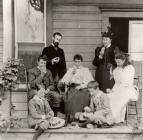 Credits:
Credits:Kelowna Public Archives #1682
32
Convinced that the Okanagan showed great promise as a fruit-growing centre and hoping to attract a good class of settlers, Lady Aberdeen noted that 'orcharding would be a delightful occupation for those with capital to invest who could also provide the good influences and high moral tone so needed in the area. ' The Aberdeens led by example and by 1892 had 200 acres of their Benvoulin and Coldstream properties planted with apples, pears, plums, cherries and peaches, which became the first 'commercial' orchards in the Okanagan.At first the Aberdeens orchards seemed to prosper, but by 1895 the Guisachan trees were in serious trouble possibly due to the alkaline soil, a high water table and not planted or looked after properly. In 1896 the entire Guisachan orchard had to be pulled out. The Coldstream orchard also had problems, but not as much replanting was necessary. It was not until the turn of the century, when the Coldstream orchard began to produce enough fruit to be considered a success. There were a couple of other commercial orchards developed in the Okanagan in the 1890s, but it really wasn't until 1903 when many new orchards were planted for the commercial production of fruit.
"Though the Aberdeens' agricultural endeavours were never a financial success, the couple's willingness to visit, to invest in the land, to build homes and to encourage others to join them put the Okanagan on the British Empire's map. In particular, their belief in the valley's fruit-growing potential attracted immigrants and it wasn't long before the Okanagan became one of the most sought-after destinations in the empire." ("The Kelowna Story An Okanagan History" Sharron Simpson, 2011, p. 52)
33
View of young orchard looking towards Kelownacirca 1909
Okanagan Mission Valley, British Columbia
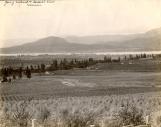 Credits:
Credits:Kelowna Public Archives #3090
G.H.E. Hudson, photographer
34
Fruit has been grown in the Okanagan almost as long as the area has been settled. Father Pandosy and the Oblate Priests planted apple trees at the Okanagan Mission in 1863. Small orchards were laid out by other settlers, such as George Whelan and Alfred Postill in 1875-76. These were small plantings intended as a supply for the ranchers themselves and perhaps a small surplus to be sold locally. There were no serious attempts at commercial fruit-growing in the Okanagan until the 1890s. This was largely due to the lack of transportation. Up to this point, cattle ranching and wheat growing were still the main industries in the Okanagan, next to subsistence farming. With the construction of the Shuswap and Okanagan Railway arriving in Vernon on May 12th 1892, things began to change. Lord and Lady Aberdeen's keen interest in growing fruit, led to the planting of 200 acres of orchards at each of their ranches . Although their orchards were not financially successful, other farmers in the Okanagan were inspired to follow their example, with roughly 75,000 trees planted (mainly apple) in the Yale-Cariboo district (largely Kelowna and Vernon areas) between 1890 and 1914. ("The Development of the Orchard Industry in the Okanagan Valley 1890-1914", David Dendy)35
First apple tree planted by Father Pandosy at the Mission siteCirca 1935
Father Pandosy Mission, Okanagan Mission, British Columbia
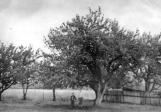 Credits:
Credits:Kelowna Public Archives #3782
36
Father Pandosy died on February 6th 1891, at the age of 67 and was buried across the road from his church, just as the new Benvoulin townsite was being developed and more settlers were arriving in the area. The Mission and the community around it continued to flourish after Pandosy's death. The farm at the Mission grew close to 2,450 acres. The Mission became the Catholic Church's headquarters for the area from the U.S. border in the south to Fort Kamloops in the north, the Similkameen Valley in the east to the Nicola Valley and Merritt in the west. When the CPR completed its transcontinental line in 1895, Kamloops became the nearest rail connection, so the Oblates moved their headquarters to the St. Louis Mission in Kamloops. The Okanagan Mission and all related properties were sold to Father Eumelin and other members of his family in 1896 (Eumelin was not an Oblate, but continued to run the Mission as its priest until 1902). In 1902, the original Mission of the Immaculate Conception was officially closed. The land went on to be purchased by the Kelowna Land and Orchard Company around 1904, then subdivided and sold as prime orchard sites. The subdivision of land opened up the area to intensive agriculture which included fruit orchards and tobacco farms.39
In 1894 Louis Holman introduced the growing of tobacco on the old Lequime place across from Leqime's blacksmith shop. This was considered part of the first 'tobacco bubble' in the area. The next 'tobacco bubble' was created by the British North American Tobacco Company (BNATCO) in 1912. This drew many local farmers into a whirlwind with its promises of a huge and lucrative tobacco industry, where tobacco would become the primary crop in the area. At one time there were eight tobacco farms in the Benvoulin area alone.The company built a large cigar factory (on Ellis Street) and leased and/or purchased farmland in the Benvoulin area and built considerable infrastructure, including a number of tobacco-curing barns. Local farmers planted over 500 acres in tobacco in 1913. At that time tobacco was grown extensively on both sides of Benvoulin Road and in other fields at Okanagan Mission as well as a site later occupied by the old Kelowna Secondary School on Harvey Avenue.
The Company went bankrupt in 1914, as a result of bad business decisions and embezzlement by a company officer. There was a tobacco revival in the area in the 1920s, until the Great Depression. Many of the tobacco barns were repurposed to store hay or serve as diary barns.
41
The McEachern tobacco barn, later owned by the McFarlane familyCirca 1973
Benvoulin, British Columbia
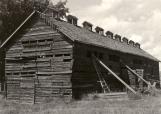 Credits:
Credits:Kelowna Public Archives #3685
42
There were many new families who bought MacKay's subdivided acreages in the Benvoulin area and became very involved in the local community. Some of these settlers included the: Munsons, Reids, Days, Hardys and Petermans. A few of these early settler's descendants are still farming on the land originally owned by their grandparents. Even with MacKay's planned townsite and his donation of land towards a new Presbyterian church to encourage development in his town centre, the Benvoulin area would remain largely an agricultural area where early settlers would come and buy land and plant orchards.45
William Dagilish Hobson and his dogCirca 1920s
Okanagan Mission, British Columbia
 Credits:
Credits:Hobson Family Collection (Robert Hobson)
46
The Day family ancestors arrived in the area in 1899 and a large acreage in Benvoulin is still farmed by family today (2012). E.A. Day (English parentage from Utah) came to the Okanagan and became friends and brother-in-law with David Lloyd-Jones, a carpenter. They went into the sawmill business together in Kelowna. Day was also the foreman at the Lequime estate, after Frank Conklin. E.A. Day bought property in Kelowna and in the Benvoulin district (currently known as the Day farm) and built a home for his seven children after the death of his young wife, Mary Jane.Archie and Julia Hardy arrived in the Okanagan in 1889 and lived on a farm on Benvoulin Road (where Orchard Park is now). Archie was a coachman for Lord Aberdeen. In 1903, Archie Hardy along with Alex Reid put up money to reopen the Benvoulin School. Archie and Julia contributed financially and physically to the construction of the Bethel Presbyterian Church. Archie was an organist at the church as well.
